
Saint Brigid of Kildare or Saint Brigid of Ireland is the patroness saint of Ireland, and one of its three national saints along with Patrick and Columba. According to medieval Irish hagiographies, she was an abbess who founded the important abbey of Kildare, as well as several other convents of nuns. There are few historical facts about her, and her hagiographies are mainly anecdotes and miracle tales, some of which are rooted in pagan folklore. They say Brigid was the daughter of a chieftain and a slave woman, and was raised in a druid's household before becoming a consecrated virgin. She is patroness of many things, including poetry, learning, healing, protection, blacksmithing, livestock and dairy production. In her honour, a perpetual fire was kept burning at Kildare for centuries.

Kildare is a town in County Kildare, Ireland. As of 2016, its population was 8,634 making it the 7th largest town in County Kildare. It is home to Kildare Cathedral, historically the site of an important abbey said to have been founded by Saint Brigid of Kildare in the 5th century. The Curragh lies east of the town.

Kilmacduagh Monastery is a ruined abbey near the town of Gort in County Galway, Ireland. It was the birthplace of the Diocese of Kilmacduagh. It was reportedly founded by Saint Colman, son of Duagh in the 7th century, on land given him by his cousin King Guaire Aidne mac Colmáin of Connacht.
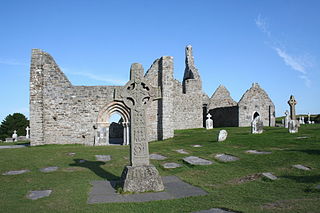
Clonmacnoise is a ruined monastery situated in County Offaly in Ireland on the River Shannon south of Athlone, founded in 544 by Saint Ciarán, a young man from Rathcroghan, County Roscommon. Until the 9th century it had close associations with the kings of Connacht.
Fedelmid mac Crimthainn was the King of Munster between 820 and 846. He was numbered as a member of the Céli Dé, an abbot of Cork Abbey and Clonfert Abbey, and possibly a bishop. After his death, he was later considered a saint in some martyrologies.
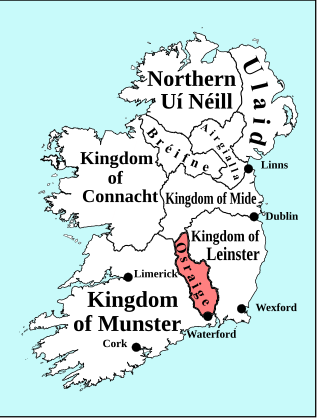
Osraige or Osraighe, Osraí, anglicized as Ossory, was a medieval Irish kingdom comprising what is now County Kilkenny and western County Laois, corresponding to the Diocese of Ossory. The home of the Osraige people, it existed from around the first century until the Norman invasion of Ireland in the 12th century. It was ruled by the Dál Birn dynasty, whose medieval descendants assumed the surname Mac Giolla Phádraig.
Killeshin is a village in County Laois, Ireland on the R430 regional road. Killeshin is a small rural community situated five kilometres west of Carlow town and overlooks the picturesque Barrow Valley. The church at the foot of the Killeshin hills is the site of an early Christian monastery.
Saint Auxilius, or Usaille, was an early Christian missionary of Ireland who is associated with Saint Patrick, Saint Seachnaill (Secundinus), and Saint Iserninus in establishing Christianity in the south of that island, although more recent studies tend to associate him with the earlier Palladius.
Events from the 5th century in Ireland.

Old Kilcullen, formerly Kilcullen, is a townland in County Kildare, Ireland, which includes a noted religious archaeological site within its boundary. As a townland it is relatively large but lightly populated. The location of the townland is roughly contained within the R418 and R448 routes starting at its most northerly point, a crossroads known locally as Thompson's Cross. The townland continues south from this point as far as Harklow and is intersected in its north east corner by the M9 motorway at Abbeyaun. Old Kilcullen was formerly the site of a walled town, and before that of an ecclesiastical settlement dating from the 5th century. The original settlement gave its name to the substantial surrounding civil parish and barony.

Inis Cealtra, also known in English as Inishcaltra or Holy Island, is an island off the western shore of Lough Derg in Ireland. Now uninhabited, it was once a monastic settlement. It has an Irish round tower, and the ruins of several small churches, as well as four high crosses and a holy well. Despite the lack of population, the cemetery on this island is still in use. Coffins and mourners are transported the short distance from County Clare in small boats. Boat trips can be taken from the harbour at Mountshannon. It is conserved by the East Clare Heritage Centre.
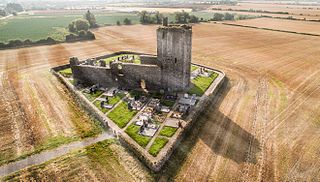
Baldongan Church, also called Baldungan Castle, is an ancient ruined church and National Monument near Skerries, County Dublin, Ireland.

Kilbennen or Kilbannon is a medieval ecclesiastical site and National Monument located in County Galway, Ireland.

Donaghcumper Church is a ruined medieval church in Celbridge, Ireland. On the Record of Monuments and Places it bears the code KD011-013.
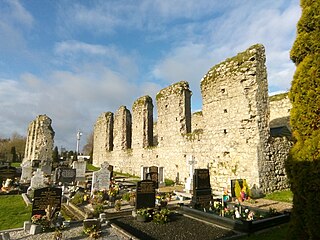
Clane Friary, also called Clane Abbey, is a former friary of the Order of Friars Minor Conventual located in Clane, Ireland.
Drumcliff Monastery was located in Cairbre Drom Cliabh, now County Sligo, five miles north of the modern town of Sligo. The site consists of the remains of a round tower and several high crosses, including one outstanding example. It is currently also the site of a Church of Ireland parish church and a graveyard. It is the burial place of the poet William Butler Yeats. Founded in the 6th century by Saint Colmcille, he is said to have declared in a later literary fragment:
Beloved to my heart also in the West— Drumcliffe at Culcinne's strand.

Dísert Óengusa is a medieval hermitage and National Monument located in County Limerick, Ireland.
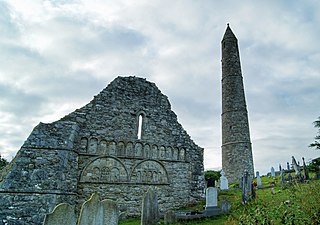
St. Declan's Monastery, containing the remains of Ardmore Cathedral, is a former monastery and National Monument located in County Waterford, Ireland.
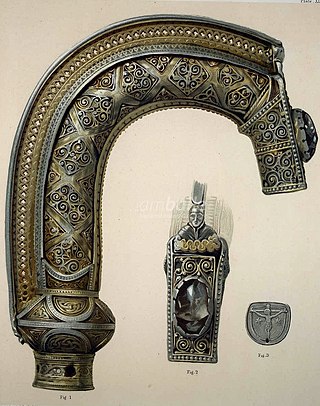
St. Fillan's Crozier is an 8th century Insular crozier crook traditionally associated with the Irish monk St. Fillan, who lived in the eighth century at Glendochart in Perthshire, central Scotland. Only the crook survives; the staff was lost at an unknown date. Sometime around the late 13th century it was encased in the Coigreach, a crosier-shrine of similar size and form built as a protective case, made from silver, gold and rock crystal and dating from the late 13th century, with additions c. the 14th or 15th centuries. The Coigreach was rediscovered in the mid-19th century by the archaeologist Daniel Wilson, who opened it and found St. Fillan's Crozier inside.

Saul Monastery is a former Christian monastery located in County Down, Northern Ireland. It is traditionally associated with the 5th-century Saint Patrick, who is said to have founded it shortly after arriving in Ireland, and having died there at the end of his missionary work.




















